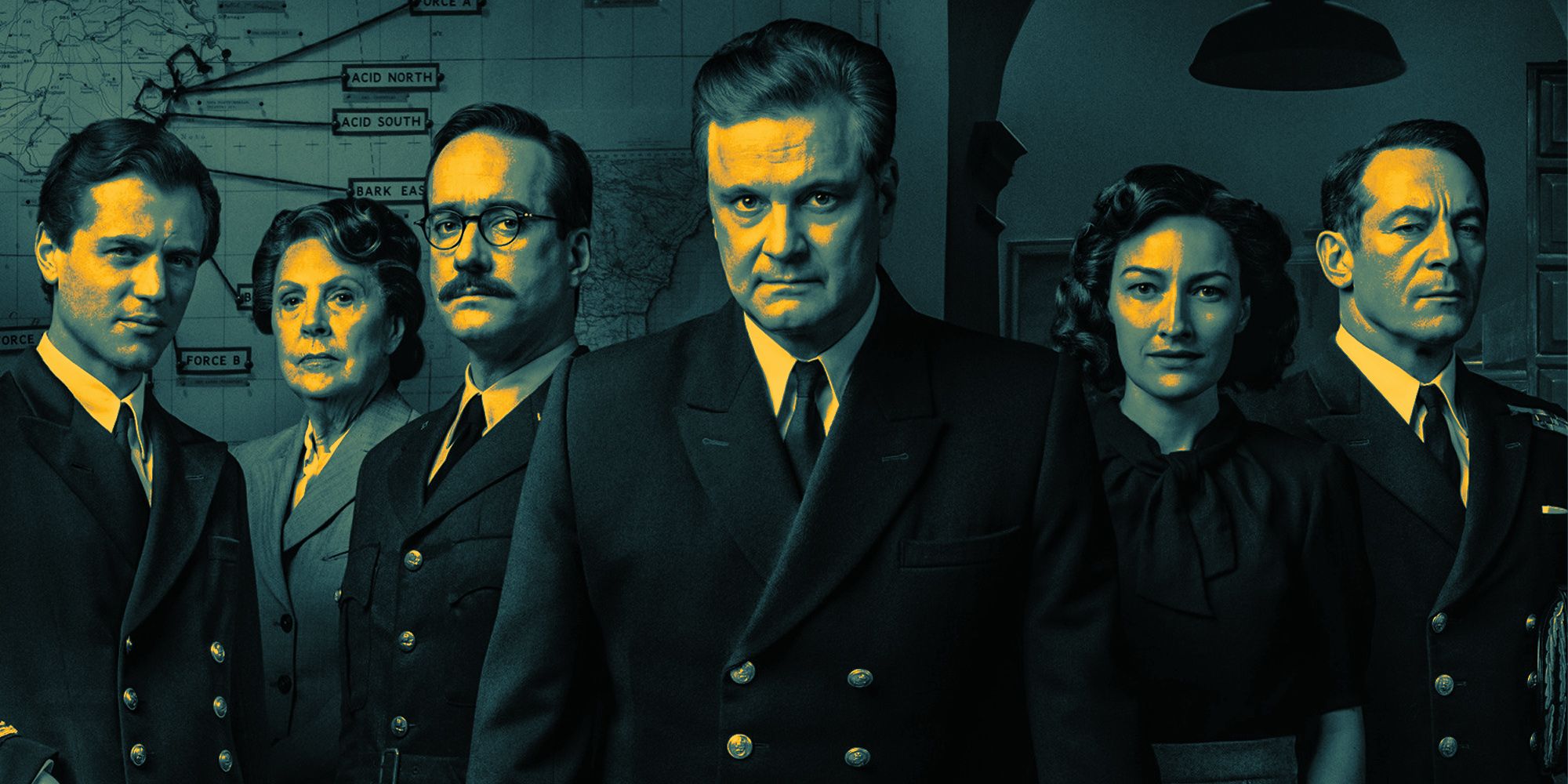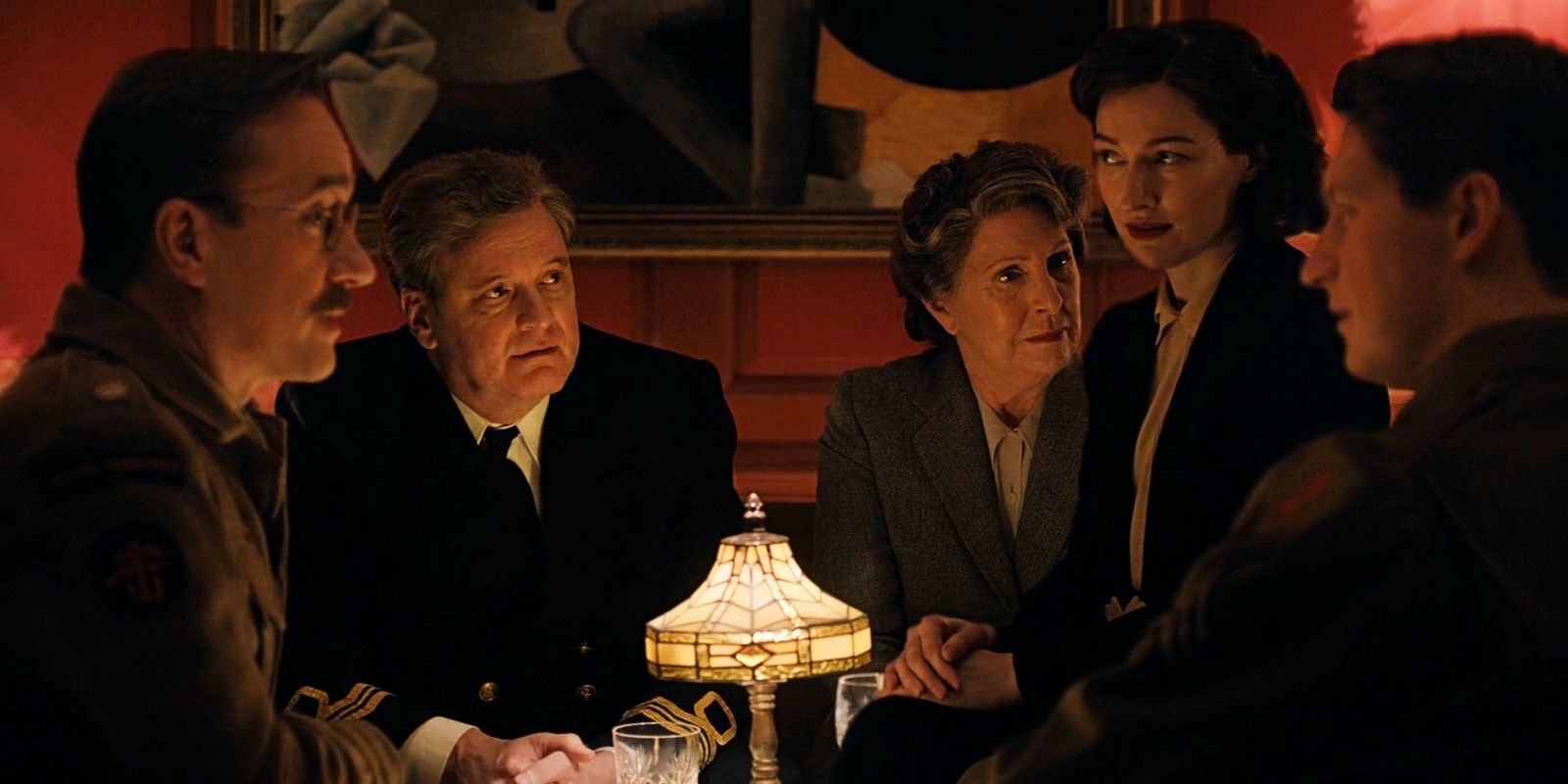Operation Mincemeat is inspired by the true events leading up to the Allied forces invading Sicily in 1943, but how faithful is the movie to Operation Mincemeat's true story? Operation Mincemeat is based on the book of the same name by historian Ben Macintyre. However, the same deception operation was also the subject of the 1953 book The Man Who Never Was (adapted into a 1956 film) written by intelligence officer Ewen Montagu, who co-led the effort and is portrayed by Colin Firth in Operation Mincemeat. Historically, the operation was set in motion by Montagu and fellow intelligence officer Charles Cholmondeley (Matthew MacFadyen), along with secretaries Hester Leggett (Penelope Wilton) and Jean Leslie (Harry Potter’s Kelly Macdonald).
Operation Mincemeat was a plan to trick Hitler into believing the Allies would invade Greece instead of Sicily. Invading Sicily to enter continental Europe was the sound choice, so the Axis powers were understandably reinforcing their position there, and the Allied forces needed to change that. Organized conjointly with Lieutenant Commander Ian Fleming (Johnny Flynn), the objective was to plant fake documents detailing the upcoming invasion of Greece on a dead body and let it wash ashore for German spies to intercept and bring to Hitler. Here's everything viewers need to know about Operation Mincemeat's true story, what the movie changes, and other facts about the most successful tactical deception operation of World War II.
James Bond's Ian Flemming Really Took Part In Operation Mincemeat
Future James Bond creator Ian Fleming is presented as the narrator at the beginning of Operation Mincemeat. He is also shown to be a writer, like many of the people working with him, including Montagu and Cholmondeley, though his iconic 007 novels weren’t yet published at the time. Surprisingly, Fleming is indeed an authentic part of Operation Mincemeat's true story, as he served as the assistant to Admiral John Godfrey (Jason Isaacs). The Trout memo, from which Operation Mincemeat took inspiration, was published under Godfrey’s name, though Operation Mincemeat author Ben Macintyre believes it mainly was Fleming who did the writing.
While Fleming was probably less involved in the operation than Johnny Flynn’s character is in the movie, he indeed called Godfrey "M," as depicted in Operation Mincemeat. The James Bond books author was inspired by Godfrey when he conceived the M character for the page, and according to Operation Mincemeat director John Madden, that isn’t the only reference to 007 in the movie. The intelligence officer helping Montagu and Cholmondeley with the set-up of the documents is part of the Q branch, and Madden revealed that Fleming was inspired by that figure for the creation of the Q character in the James Bond series. Operation Mincemeat's true story was foundational to the Bond franchise.
The Ewen/Jean/Charles Love Triangle Never Happened
Operation Mincemeat really placed an old photograph of secretary Jean Leslie in one of the dead body’s pockets, but the love triangle between Ewen Montagu, Jean Leslie, and Charles Cholmondeley never actually happened. According to Operation Mincemeat screenwriter Michelle Ashford (who also wrote for the World War II series The Pacific), Montagu and Leslie really wrote to each other as if they were Bill and Pam. However, there was no mention of Cholmondeley being jealous of their relationship.
Still, historian Ben Macintyre believed Montagu and Leslie actually were in a romantic relationship. When he asked the real Leslie about it, however, she refused to answer, leaving the question hanging. This is just one of the many complications regarding Operation Mincemeat's true story.
Glyndwr Michael's Sister Appearance Was Completely Fictional
The body chosen for Operation Mincemeat was that of a homeless man named Glyndwr Michael. Almost everything the movie says about him is true, like the fact that he was buried in Spain as "William Martin," and only in 1996 was his role in Operation Mincemeat revealed and subsequently acknowledged on his tombstone. However, Michael’s sister appearing to reclaim his body is entirely fictional. Ashford stated that with that storyline she wanted to portray “the messiness of war” and convey that Glyndwr Michael was a person and not just a prop in the mission. Indeed, it's a fictional addition humanizes a central figure in Operation Mincemeat's true story.
Operation Mincemeat Was Inspired By A Novel (But Its Name Wasn't)
Operation Mincemeat has the Ian Fleming character mention that section 28 of the Trout memo was inspired by a novel. That was also true in real life, as revealed by historian Ben Macintyre. He noted in an interview that the original idea to plant fake documents on a dead body of a drowned airman was taken from Basil Thomson’s The Milliner’s Hat Mystery. Thomson was a prewar author of detective novels, famous in his day but almost entirely forgotten nowadays, and a crucial character in Operation Mincemeat's true story.
Although quite truthful, Operation Mincemeat implies that the operation’s name came from the gruesome nature of the plan. While Cholmondeley really did initially propose "Trojan Horse" as an operation name before later changing it to "Mincemeat," the name wasn’t given because of the operation’s morbid nature. Instead, the name Operation Mincemeat was drawn from a list of meaningless operation titles, chosen randomly as all World War II mission names were to avoid predictability.
Spanish-Allied Forces Almost Stopped Operation Mincemeat
Operation Mincemeat shows the operation going surprisingly slow when the body reaches the village of Huelva in Spain, so much so that it needs to be aided by naval officers on the ground in order to reach the German spies’ hands. In reality, the first part of the operation went as planned, and some local fishermen found the body. Instead of being turned over to the Nazis, though, the body ended up being discovered by Spanish officials loyal to the Allies. As they didn’t know of the operation and knew Martin belonged to the UK, they almost sent his body to England straight away, risking the success of the whole Allied forces mission.
No German Anti-Hitler Spy Actually Knew Of Operation Mincemeat
One worrisome development in Operation Mincemeat involves Jean Leslie. The manager of the club she often goes to with Montagu, Cholmondeley, and Hester Legget reveals himself to be a German spy and manages to find her at her home to interrogate her about the operation. When the invasion of Sicily succeeds with little opposition, Montagu and Cholmondeley are sure that it’s because the spy was working for Alexis von Roenne, a Nazi official secretly opposing Hitler.
In the real Operation Mincemeat, however, no German anti-Hitler spy got wind of the operation. Von Roenne really existed, and he was executed for trying and failing to assassinate Hitler in the July 20 Plot (depicted in the Tom Cruise movie Valkyrie). That said, he was never privy to Operation Mincemeat.
The Director Of Operation Mincemeat Didn't Take These Changes Lightly
Despite all the movie's changes to Operation Mincemeat's true story, it's clear that director John Madden treated the matter with due reverence, respect, and research. Considering how well Madden and his crew adapted the story without losing the most crucial details, it's no surprise that the director is a student of history. "In all significant details it’s true. But you do need to shape the narrative to maximize its impact," explained Madden (via Historynet).
There are some elements we shifted around. That was actually true of the story’s first iteration: Ewen Montagu, the man who was in the middle of the whole thing, later wrote his own account, “The Man Who Never Was” (1953), which was heavily vetted by intelligence services and was in itself what amounted to a work of fiction because one of the key elements was they didn’t own up to whose body they were using — a very, very sensitive subject.
Indeed, though not 100% faithful to the Operation Mincemeat true story, Madden had everything they needed to craft a fictional story that did justice to the real events. "So there is an absolute enormous tranche of information and detail about Operation Mincemeat, and so we had the advantage of being able to tell that story very honestly." Immortalized in the film, Operation Mincemeat's true story remains one of the most noteworthy, unique, and ultimately uplifting real events to result from the horrors of World War II.







